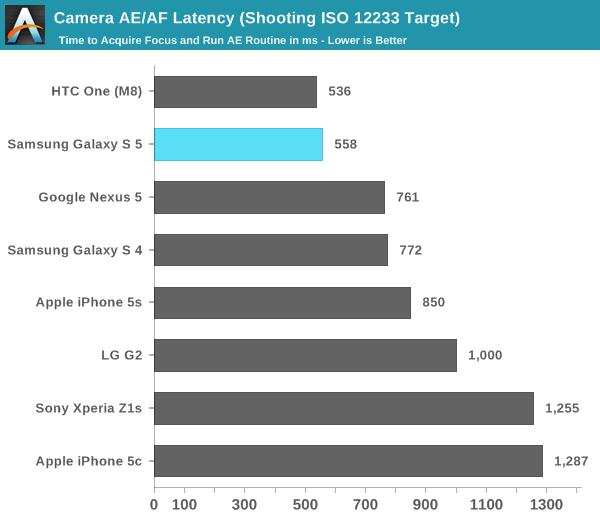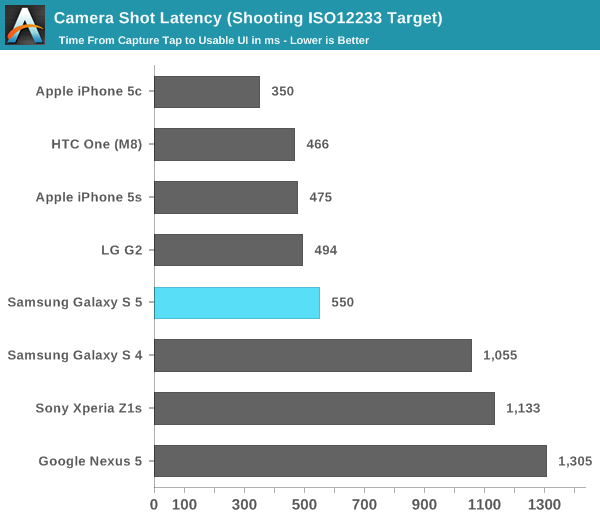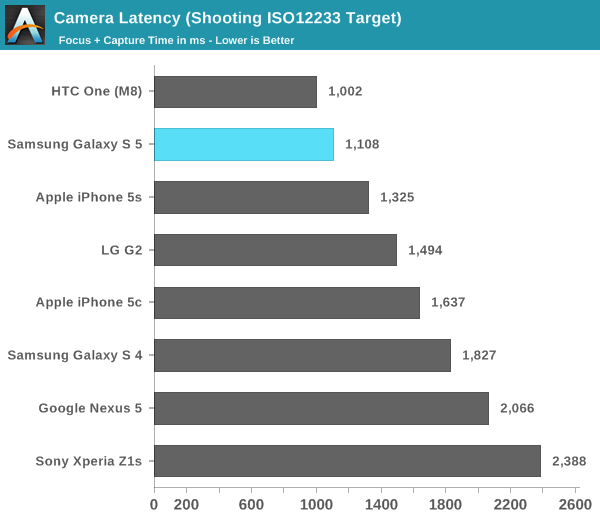Samsung Galaxy S 5 Review
by Anand Lal Shimpi & Joshua Ho on April 8, 2014 12:00 AM EST- Posted in
- Smartphones
- Samsung
- Mobile
- Galaxy S 5
Capture Latency
Along with its own rear facing camera sensor, the GS5 adapts a dual-mode autofocus system. Traditional AF designs in smartphones rely on testing contrast differences in order to determine when a point is in focus. With GS5, Samsung introduces a second mode: phase detection auto focus. Instead of relying (primarily) on contrast to determine focus, PDAF splits incoming light and compares intensity patterns to determine focus direction.
Low light scenes and scenes that can't generate appropriate phase info will default to contrast AF. PDAF appears to work across the camera's FOV although I did notice that the fastest AF times almost always happened in the center of the display.
Samsung claims a 300ms AF time thanks to its phase detection AF. In order to validate that claim I pointed a camera at a bunch of phones and measured AE/AF latency while preparing our ISO 12233 target shots from the previous page.
I measured from the moment I tapped the focus target to the time the image stopped moving (I didn't rely on the AF lock indicator as some devices report focus lock prematurely). There's a bit more variance than I'd normally like in these numbers due to the nature of the capture, although I'm working on getting a higher speed camera to smooth some of that out.

The GS5 definitely runs its AE/AF routine quickly, basically tying the M8 at the top of the charts here. The improvement over the GS4 is substantial, and there's even a big advantage over Apple's iPhone 5s. Note that if you move to lower light conditions you can see this number at least double, but that's something that impacts all of the devices here.
The Z1s is pretty frustrating because it has a great imaging system but an absolutely terrible camera UI. Focus speed is pretty bad compared to anything else here, basically on par with the iPhone 5/5c.
The shortest time to focus I was able to record on the GS5 was 450ms in a different test scene, compared to 516ms for the M8. The GS5 can definitely be a hair faster but I found the M8 to be comparable if not slightly quicker overall.
Focusing is just one piece of the puzzle, I also measured capture latency as well. Here I'm looking at the time between when I tapped the capture button on the screen and when the camera UI was ready to take another shot.

The GS5 remains solid, but here Apple actually pulls ahead. The 5c (and 5 by extension) are actually at the top of the charts here. Apple does some more work upon capture on the 5s, which is the only reason I can think of for the discrepancy here. Either that or the NAND on my 5s is in a dirtier state, impacting capture performance.
Either way there's a huge improvement in capture speed compared to the GS4. Capture latency is one area where the Nexus 5 is absolutely horrible in. The latest updates made AE/AF reasonably responsive, but the capture latency kills the experience on the N5.
This next chart combines the previous two values to give an overall picture of capture latency on these devices:

Samsung's PDAF and ISP companion seem to do their job well as the GS5 is substantially quicker than the GS4 at image capture. That being said, HTC's M8 is slightly faster by comparison.










296 Comments
View All Comments
nerd1 - Wednesday, April 9, 2014 - link
Samsung still makes the most well-around and practical phone out there. It's funny so many people are crazing the metal stuff that bends and scratches without case.synaesthetic - Wednesday, April 9, 2014 - link
I used to love Samsung phones, but not so much anymore. If I'm going to spend 600 bucks on a phone, can we please stop making it feel like a toy? I'm not saying anything about using metal; Nokia's Lumia devices are made of polycarbonate but they feel rock-solid and excellently constructed.AMOLED? Meh. IPS is where it's at. AMOLED's oversaturated to the point of cartoonishness. With AMOLED, in six months of decently heavy use, tons of the blue subpixels burn out and the display gets weird unless you're very, very careful to make sure that all your subpixels wear evenly. White webpages drain the crap out of battery. I had a Galaxy Nexus for eighteen months (the one with the RGBG pentile matrix that's supposed to reduce the effects of subpixel burn out) and within half that time I had blue stripes where the status bar and nav bar were whenever I put it in landscape mode. IPS doesn't have this issue; my Nexus 4's screen looks exactly the way it did when it was new, eight months later.
The only new device I really care much about right now is the Xperia Z2. Sony phones have been awesome for a while now except for Sony's insistence on using crap screens, but the Z2's display is amazing. Not oversaturated, looks natural and fantastic, has great viewing angles... not to mention an sdcard slot and a gigantic battery.
Samsung doesn't sell a ton of phones because they're the best device, just like Apple doesn't. They both sell a ton of phones because they both spend a ridiculous amount of money on marketing.
ashleynelson548 - Wednesday, April 9, 2014 - link
My review is simple. Get in line and get this phone: http://amzn.to/1ksys3o - Got a chance to test it and this is one awesome phone. Finally Samsung got something right with the S5. I've had HTC & Samsung phones prior to the Galaxy series came out. And nothing has come close to this phone. Great resolution, great camera, love it still has a sd slot to expand your storage capacity along with the high gb internal memory. Lots of ways to tweak to your liking.SymphonyX7 - Thursday, April 10, 2014 - link
Anyone know how Anandtech measure the phone's power consumption? Do they just hook up a voltmeter between the battery terminals, get the voltage readout and compute from that?nerd1 - Thursday, April 10, 2014 - link
I think they used in-line powermeter.Stiv21 - Thursday, April 10, 2014 - link
This fake , here's flagshiphttp://pdadb.net/index.php?m=specs&id=6040&...
RonaldNCoady - Friday, April 11, 2014 - link
People who are been obsessed with stock experience pushed to their phones the minute Google announces a new update buy a Nexus phone. Everyone else buys the phone they feel best suits them. Most people teds to buy Galaxy S phones, simply because they are the best, and one of the very few with an OLED display. http://evo9.it/qr.net/aacrodex - Friday, April 11, 2014 - link
I really didn't get the capture latency part. Unlike iphone, android phones support continuous drive, so if you want to capture multiple photos, just don't release your finger.abufrejoval - Friday, April 11, 2014 - link
I am (actually more than a little) disappointed that Samsung is trying to do the right thing on one hand with the introduction of Knox for securely running enterprise applications on these devices, yet on the other hand not taking suffient care to really enable them to be what they are:Very small and portable yet incredibly powerful workstations, quite capable of replacing entry level PCs by just sticking them into (better placing them on a wireless) docking station, which has a set of full sized screens, keyboard and mouse connected to them so you can run either light office applications right off the phone or use Citrix (or any other terminal server protocol) for some heavier stuff, which still requires a beefy VDI to run.
To call them "phones" today is like calling a PC a "word processor": Sure that's how they started, but that's not what the have become.
I bought the Note 3 (like its predecessor, a Note 1) as a very personal workstation, also bought the docking station, which gave me HDMI video and audio out as well as 3 USB (2.0) ports, but I was extremely disappointed to find that the "handheld workstation" wouldn't properly initialize the Asix USB Ethernet adapter, which *every* Android I've ever tried works with out of the box.
And the monitor was little better: Even though the phone's screen is actually turned off with KitKat and orientation properly switches to landscape mode, all UI elements look groteskly swollen because they were sized to fit a 1080p resolution on a ~6" screen, but not the 32" LED TV I use on my desktop. Needless to say that word processing is no fun when letters are taller than your thumb.
Clearly the only use case Samsung seems to support via the HDMI port is watching movies: Something I don't need a workstation for.
After no essential Knox features or applications were forthcoming I went ahead and rooted my Note 3, essentially killing any chance of ever using Knox on that device now. With two "netcfg eth0 dhcp" commands in sequence I can now properly bring up Ethernet and thus connect to the securized office LAN and run Citrix, but with the built-in and fixed DPI settings all other desktop use is still painful to look at.
There are of course solutions to that problem: Any Parandroid ROM and derivative has wonderful multi-DPI support built in, but unfortunately since the MHL adapter in the Samsung devices doesn't have an open source driver, you immediately loose the HDMI connect, once you put one of these multi-DPI capable Androids on the workstation: Catch-22!
The only one who can fix this is Samsung and it doesn't look like they are using this opportunity to make their devices more appealing for enterprise use.
I have quite a number of Android devices and having a different flavour on each one of them would make them pretty unusable. So I put Omnirom on all my Galaxys (except the Note 3), my Nexus 4, 7, 10, Oppo Find 5, Asus TF101, Notion Ink Adam and even switched the return and menu keys around on all the Nexus devices to put them back where "God" (Samsung) intended them to be on my first Galaxy S, with home in the center.
And since the original launchers were always far too limited and boring I've been running SPB 3D shell on all of these devices for years, which gives me both speed and a nice look as well as a level of consistency across phone, portrait and landscape tablet sized Androids, not possible otherwise.
Custom Androids give me choice, configurability and privacy: Let the hardware vendors concentrate on creating the best workstation they can make and leave the OS alone!
I bought a post-PC darn it, like in "personal" not a blackmail subscription!
tomgadd - Sunday, April 13, 2014 - link
Why are the tester do not test audio quality??The background is, that people between 15-30 years do consume 90% of music on their smartphone. So it would be a smart move to give the audio quality a higher priority in the test.
Finally the S5 has in my view the best audio quality available on a smartphone these days.
A really smart move from samsung....that was formerly one of the key the departements of apple....Sadly the competitors needed a few years to understand the importance...